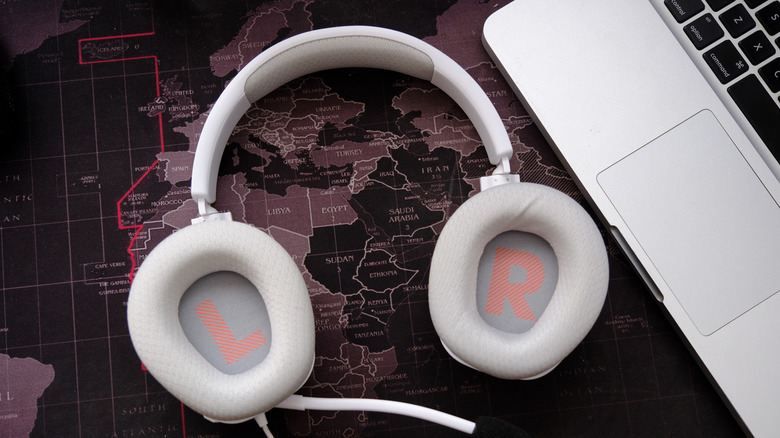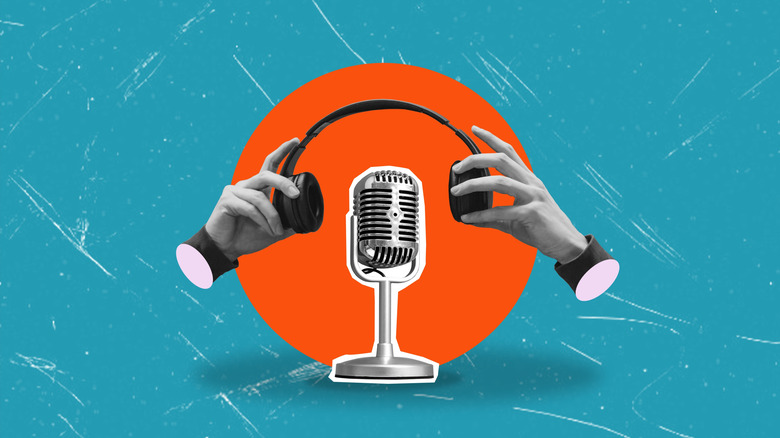Why Do Headphones Have Left And Right Sides?
You've probably noticed that many headphones and earbuds have markings on them to denote left and right. But does it really matter which way you put your headphones on? The left and right markings make sense for earbuds, where each one may be shaped differently to accommodate your ear ergonomically. Some headphones also have slanted ear cups to more naturally fit our opposing ear shapes, but what about headphones that are completely symmetrical? Why does it matter which way they're worn?
The way humans naturally hear the world around us is the main reason there is a proper, left-right orientation for headphones. When people mix music and other audio, the same principles are used to provide a feeling of presence and spatial dimension to the listening experience. Consider what would happen if you were playing a video game or watching a movie with your headphones on backward. You'd hear sound effects, dialogue, and more coming from the opposite direction they're intended. To understand why this is, we'll take a simple, easy to understand look at some of the most important auditory science headphone owners should be aware of.
Stereo imaging and soundstages explained
Most audio in the modern era is mixed in two, separate channels — left and right. Two-channel sound is called stereo, and it remains the gold standard for recorded audio because humans typically have two ears. When we hear noise, like an oncoming car while crossing the street, we're able to tell which direction it's coming from. The human brain calculates the time it takes between when a sound is heard in one ear and the other, as well as its relative loudness in each ear, to tell us which direction it's coming from, much in the same way we use two eyes to gain a three-dimensional view of the world around us. There's a lot more to it, of course, but as far as headphones are concerned, that's what you need to know.
The perception of different audio elements (for example, discrete instruments in a song) in an imagined space while listening to headphones is called the soundstage. To understand the concept, imagine you're standing on stage with a live band. Behind you is the drummer, to your left is the guitarist, and to your right is the singer. Headphones with a good soundstage can make it seem as though you're hearing the music in a similarly three-dimensional way.
Audio engineers pan elements in an audio mix to the right or left to simulate a three-dimensional environment within the soundstage, creating that immersive experience. This is called stereo imaging. If you've never noticed it in your favorite music or movies before, you can try putting on some headphones and watching this video from Woo Audio. It demonstrates how two channels can be used to make it appear that audio is coming from the left, right, or center.
What affects your stereo experience with headphones?
Just because you're wearing your headphones the right way doesn't mean you'll experience mind-blowing stereo imaging. Good imaging only occurs when a number of factors all line up correctly. First, the audio you're listening to must be mixed well. Audio engineers spend a lot of time calibrating different tracks in a song or movie to ensure everything is placed correctly. They use panning tools to move a sound left or right, stereo delay tools that send sound to one channel milliseconds before the other, and so on. There are far more tools used than we have time to cover, all of which add to the stereo effect and require a precise touch. Once the audio has been mixed and mastered, you need to be listening to it in a high enough quality to hear the stereo image. Most music streaming services accomplish this easily, as do physical formats like CDs, but low quality MP3s might not.
Finally, your headphones or earbuds need to be of a high enough quality to reproduce the stereo image. You don't need the best over-ear headphones, although the better they are, the more you'll hear fine details in the mix. Mid-range or better — think basic AirPods, or Sony ULT Wear headphones — will definitely get the job done. You might even have good luck with some cheaper models. On the other hand, don't expect great stereo imaging from $10 headphones you picked up at a drugstore. Things get even more nuts when you enter the world of 360-degree spatial audio, but that's beyond the scope of this article. Whichever cans you have, though, don't put them on backward.


